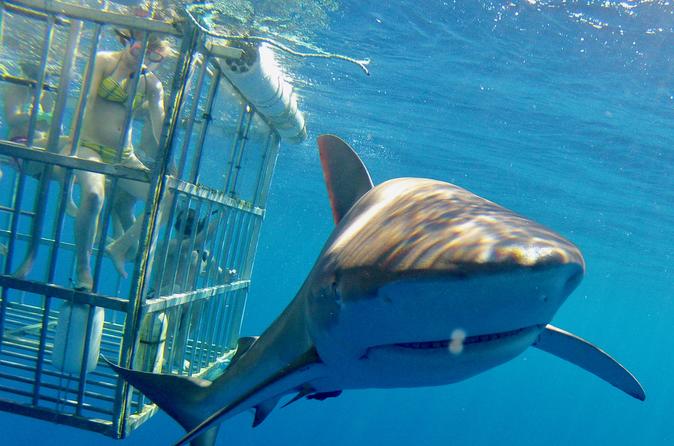The surprise arrival at the feast was big and regal and as wide as your grandmother’s hot rod Lincoln, and when she cruised onto the scene the other diners fled — as was only natural, for she was a great white shark, said Ocean Ramsey, who studies sharks, advocates for their conservation and leads educational, cage-free shark diving tours on Oahu’s North Shore.
On Jan. 15, Ramsey and her team had taken their dive boat to monitor tiger sharks feeding off a dead and decomposing sperm whale that National Oceanic and Atmospheric Administration had towed 15 miles offshore from Sand Island, where it had lain against the shoreline, attracting sharks, when, to her astonishment, the female great white appeared.
“We saw a few tigers and then she came up and all the other sharks split, and she started brushing up against the boat,” Ramsey said in a phone interview that evening, her voice trembling with exhilaration and exhaustion after swimming with the shark all day. “She was just this big beautiful gentle giant wanting to use our boat as a scratching post. We went out at sunrise, and she stayed with us pretty much throughout the day.”
Great white sharks, classified as a vulnerable species, are rare in Hawaii, where the water is too warm compared with the cold Pacific coast of California where they feed on sea lions and elephant seals, Ramsey said. And this individual, she added, was rarer still given her record size, which Ramsey estimated as more than 20 feet long and eight feet high.
Not only that but “She looks like she may be pregnant: She’s shockingly wide,” Ramsey said.
Hunger and need for nutrients in pregnancy may have explained the shark’s presence in Hawaii, where, one theory has it, pregnant great whites follow whales.
One thing that surprised Ramsey was the presence of dolphins, who usually avoid great whites. “There were two rough-tooth dolphins escorting her, nudging on her fins, twirling around her nose. These guys wouldn’t leave her alone — they were having so much fun.”
She was especially thrilled because, based on the shark’s size and markings, she tentatively identified her as Deep Blue, a shark she has swum with on research trips to Guadalupe Island, Mexico. “I’m without words; it’s heartwarming; she’s probably the most gentle great white I’ve ever seen. Big pregnant females are actually the safest ones to be with, the biggest oldest ones, because they’ve seen it all — including us.” (Sharks only bite humans when they are curious or mistake people for their natural prey, she said.) “That’s why I kind of call her, like, a grandma shark.”
But, Ramsey cautioned, gentle is relative when it comes to great white sharks and tiger sharks, who are apex predators and unpredictable. She warned recreational boaters and divers to stay away from the dead sperm whale site, where her team was working with a permit from NOAA.
That day, for instance, the great white went up to one of the recreational boats “and she sort of gently mouthed their inflatable (fastened to the side of the boat) and popped it, and those people left shortly after that.”
Indeed, state officials today warned everyone to stay away from the carcass and the sharks.
Jason Redulla, chief of the state’s Division of Conservation and Resources Enforcement, said in a news release today, “We’re asking people to stay out of the water around this carcass. We don’t want anyone to get hurt if a shark swimming around the carcass mistakes them as food. Understandably, some people want to get into the water either out of fascination or to get photographs, but it is truly dangerous to be around this carcass with so much shark activity.”
State officials said the decomposing whale carcass has moved to about eight miles south of Pearl Harbor, even though it had been towed from just off Sand Island to about 15-miles south of Oahu. They said winds and currents could push it closer to shore or even back onto land.
For Ramsay, however, the great white shark’s island visit couldn’t have been better timed as she tries to drum up support for legislation against the intentional killing of sharks. She is seeking to have the measure introduced in the state House this month. While Hawaii was the first state to ban shark finning in 2010, “that doesn’t mean you can’t kill sharks,” she said, noting that two to three sharks are killed every second.
Sharks foster healthy marine ecosystems by picking up dead and injured animals, which keeps disease from spreading, Ramsey said.












